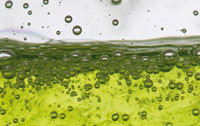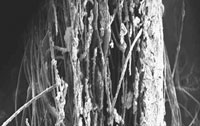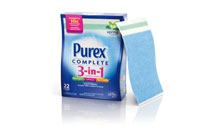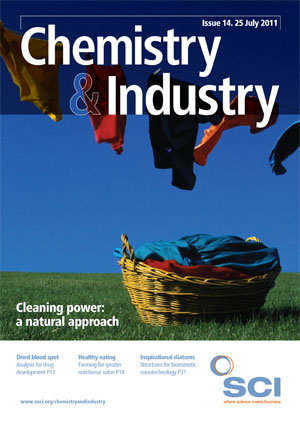Water is the best solvent there is, according to Molly Busby, a researcher in Dow Chemical’s fabric and surface care business. It is a strong, polar solvent and also the cheapest solvent; it is non-toxic, nonhazardous and non-flammable; it is odourless, completely eco-friendly and readily renewable, she told delegates at the Cleaning Products 2010 conference held in Alexandria, US, in late 2010. But while water is excellent for removing polar substances, Busby emphasised that it needs the help that organic solvents provide for non-polar soils, like grease, sebum and some particulates. And organic solvents are increasingly being examined for replacement with renewable substances.
‘Renewable’ issues
But confusion over the use of the term ‘renewable’ is as prevalent for cleaning products, as it is for bioplastics (C&I 2011, 10, 21). As Guido Bognolo, from the Belgian consultancy WSA Associates, pointed out at the 2011 annual forum of the British Association of Chemical Specialities, the term renewable is often used as a synonym for natural ‘but natural is not necessarily “good” and natural or renewable is not necessarily sustainable’.
Bognolo said that the absence of a clear term and independent regulatory rules results in arbitrary claims and interpretations. ‘Raw material producers and formulators therefore need to adopt voluntary higher standards of transparency in marketing and honesty in communications, based on scientific evidence and common sense,’ he said. ‘It is difficult to give a definition for renewable, especially for surfactants, as 100% renewable surfactants do not exist.'
Some ‘green’ cleaning products contain a surprising amount of carbon that is not from a renewable resource, researchers reported at the 2011 spring meeting of the American Chemical Society in Anaheim, California. Cara Bondi and colleagues, from cleaning product manufacturer Seventh Generation, described their analysis of more than a dozen samples of commercial liquid laundry detergents, dishwashing liquids, and hand washes. ‘Not all carbon is created equal - carbon originating from petroleum is clearly not from a renewable resource. No one can dispute that we need to use less petroleum and consumer products are no exception,’ Bondi said. With no legal or standard definitions of sustainable, natural, or renewable, she and her colleagues asked: Where did the carbon in these products originate? Did it come from plants or from petrochemicals produced synthetically from petroleum? To answer the question, Bondi’s team used a variation of the carbon-14 dating technique.
The products tested showed significant variation in plant-derived carbon content: hand washes ranged from 28% to 97%, liquid laundry detergents from 28% to 94% and dishwashing liquids from 43% to 95%. The research also revealed that allof the products tested that are positioned in the consumer market as ’green‘ contained over 50% more plant-based carbon on average than product samples tested without such positioning.
‘Some of the other findings, however, were a surprise,’ Bondi said. ‘The plant-derived carbon content of the product samples tested was largely inconsistent with some of the content claims made on packaging. For example, a liquid laundry detergent that makes the claim ‘petrochemical free’ contained only 69% plant-based carbon, meaning that 31% of the carbon in this sample is, in fact, petroleum-derived.’
‘For the samples tested, our results clearly indicate that even though “green” claims are made on package labels or in advertisements, these claims are not necessarily an indication of where the carbon in these products is coming from,’ Bondi added.
‘Carbon derivation is the cornerstone of sustainability and, as such, understanding the ratio of plant-derived versus petroleum-derived carbon is critical for both consumer product manufacturers and raw material suppliers who are trying to minimise petrochemical use,’ Bondi said.
Three routes to renewable surfactants
According to Bognolo, renewable surfactants can be derived in one of three ways:
- directly from natural sources, such as lanolin and lecithin;
- by chemical modification of natural raw materials, like vegetable oils and animal fats, and also further synthesis of chemically modified natural materials, like the sorbitan esters, sugar esters, fatty acyl amino acids and peptides; and
- through biosynthesis of, for example, glycolipids and lipopeptides.

Bognolo explained they have been rescued by consumers responding to messages emphasising eco-friendliness and formulators have therefore begun to move away from what he referred to as ‘perceived evils’, although higher cost can still make such products non-competitive with their synthetic alternatives. ‘But the gap is narrowing as a result of the use of lower cost resources, such as chicken fat,’ he added.
Bognolo concluded that formulation skills will be the key driver in replacing synthetic surfactants. ‘Researchers need to look at what the market needs rather than what they can produce,’ he noted.
Designing surfactants
At the Cleaning Products conference, Stepan’s Dennis Murphy outlined the key aspects that need to be considered when designing a new surfactant, with cost/performance coming first on his list as it has an impact on the adoption of any new products. Any new speciality surfactant must provide benefits that justify its cost, he said.
Supply chain issues of the raw materials used to produce a surfactant are equally important. Raw materials should be available from multiple sources, preferably in all geographic regions, with multiple manufacturing sites preferred in the event of mechanical breakdown or natural disaster.
Regulatory clearance for the new surfactants must be obtainable, said Murphy, adding that both environmental and safety aspects need to be considered. And sustainability of the raw materials is vital for the near future, Murphy believes petrochemical-based feedstocks will remain widely available but he noted that ‘biorenewable-based feedstocks are increasingly being used in innovation activities, in part, to plan for the future’.
‘The success of a new surfactant will be dictated by the relative strength of the weakest link of these key elements,’ he said, illustrating his point with Stepan’s new anionic surfactant for laundry applications Sulfo-Estolide (SE) a sulfonated oligomeric surfactant. SE surfactants are synthesised by sulfonating an unsaturated fatty acid, such as oleic acid from palm oil or tallow, or a combination of unsaturated and saturated fatty acids. All these materials, he said, are registered, while palm oil or tallow is globally available from multiple sources, with no foreseeable disruption in their supply to Stepan facilities around the world. The new surfactant could be utilised in concentrated liquid formulations with low-foam properties and would be slightly cheaper to produce than the traditional linear alkylbenzoate surfactants.
The successful design and development of surfactants in the future will increasingly require the simultaneous meeting of multiple criteria, explained Murphy. An understanding of structure and property relationships can be a powerful tool for optimising performance because a new surfactant will be required to perform under all application conditions in all types of washing equipment. For efficient resource utilisation, it will be essential to target surfactant design and development efforts against market trends, like colder wash temperatures, lower water consumption and increasing pressure on VOCs, he said.
Akzo Nobel is developing cost effective, hybrid surfactants that combine plant-based and petrochemical materials in a polymer. Klin Rodrigues, speaking in Alexandria, explained that the approach involves hanging synthetic monomers on a polysaccharide backbone, which, he said, gives ‘many new levers to pull’.
The first generation hybrid surfactants, available as Alcoguard, Rodrigues said, give an increase in biodegradability from zero to 65%, as well as offering 44% lower energy use, 43% lower petrochemical resource depletion, 40% lower CO2 emissions and a 40% lower contribution to ground level ozone. In terms of performance, he pointed out that they are similar to their synthetic counterparts in laundry applications in terms of anti-redeposition, dispersancy, anti-crustation and detergency. The next stage of development is to replace the synthetic monomers with renewable monomers, thereby increasing the renewable carbon index from 62% to 85% and eventually greater than 95%.
In a renewable hard surface cleaning development unveiled in Alexandria, Ulf Baus, from BASF introduced HStar Proteins, which are based on hydrophobins derived from fungi combined with a bacterial protein. The material spontaneously adheres to all interfaces, exhibits good chemical stability at temperatures up to 150oC, is non-toxic and readily biodegradable. The material offers improved wetting and soil repellency on hard surfaces, depositing a semipermanent protein coating that can easily be removed with proteases.
Formulation matters
Getting the right ingredients is only one aspect of producing a new cleaning product, the formulation of the final product is the make or break of a new product. In the laundry detergent market the trend has been away from powders to liquids and, more recently, concentrated liquids.
As Michael Coxey, from Cognis, pointed out to delegates at the Cleaning Products event, the year of 2x concentrates was 2008 in the US, driven by the so-called ‘Big Box’ retailer Walmart. At the end of 2009, Walmart said that by selling only concentrated laundry detergent for three years, more than 80m lb of plastic would be saved; more than 430m gallons of water would be preserved; and more than 125m lb of cardboard saved.
Since then the leading detergent marketers have gone from 2x to 4x and now 8x concentrated products. As Coxey pointed out, however, ‘increasing the concentration doesn’t consistently reduce the dosing rate – not all doses are created equal’.
The formulation challenges for ultra concentrated liquid laundry products are complex, said Coxey. First there is the issue of stability – high surfactant and builder levels with less water present more compatibility issues, while high anionic surfactant and electrolyte levels require more hydrotrope/ solvent to keep the viscosity down. In addition, the incorporation of enzymes and stabiliser systems becomes more difficult with very low water levels. Rapid dissolution is required even in cold water and a more hydrophilic surfactant system with controlled foam behaviour is essential. Finally, Coxey emphasised that as the need for highly concentrated or anhydrous surfactants increases all the required raw materials need to be highly active.
All this is not to say that all these requirements mean that renewable raw materials are excluded. Coxey pointed out that Cognis’ Smartclean technology, which utilises a plant-based formulation, has been adopted for the 8x concentrated laundry detergent, Method in the US, which offers a 35% smaller carbon footprint than conventional detergents.
Innovative solutions - like 'all-in-one' laundry sheets - meet the trend for more convenient products
Laundry detergents have changed dramatically, from soap bars, through powders and liquids, to concentrated liquids and encapsulated products. The latest US development from Henkel is Purex, which incorporates detergent, fabric softener and an antistatic in a non-woven sheet, to meet a market trend for more convenient cleaning products that are ‘all-in-one’, like disposable cleaning wipes.

In terms of the detergent, a mouldable material was required because it had to be applied to the non-woven sheet at production speeds, currently 3000 sheets/ minute. The sheet therefore had to be highly absorbent for the detergent while remaining intact through all stages of the laundry process, at all temperatures. The current sheet has different properties on either side (see left), puffed on the front for the detergent and flat on the back for the softener. The softener is drawn through the sheet by the heat in the dryer. Fragrance delivery is also crucial and had to be achieved while the sheet is wet and after the drying cycle.






